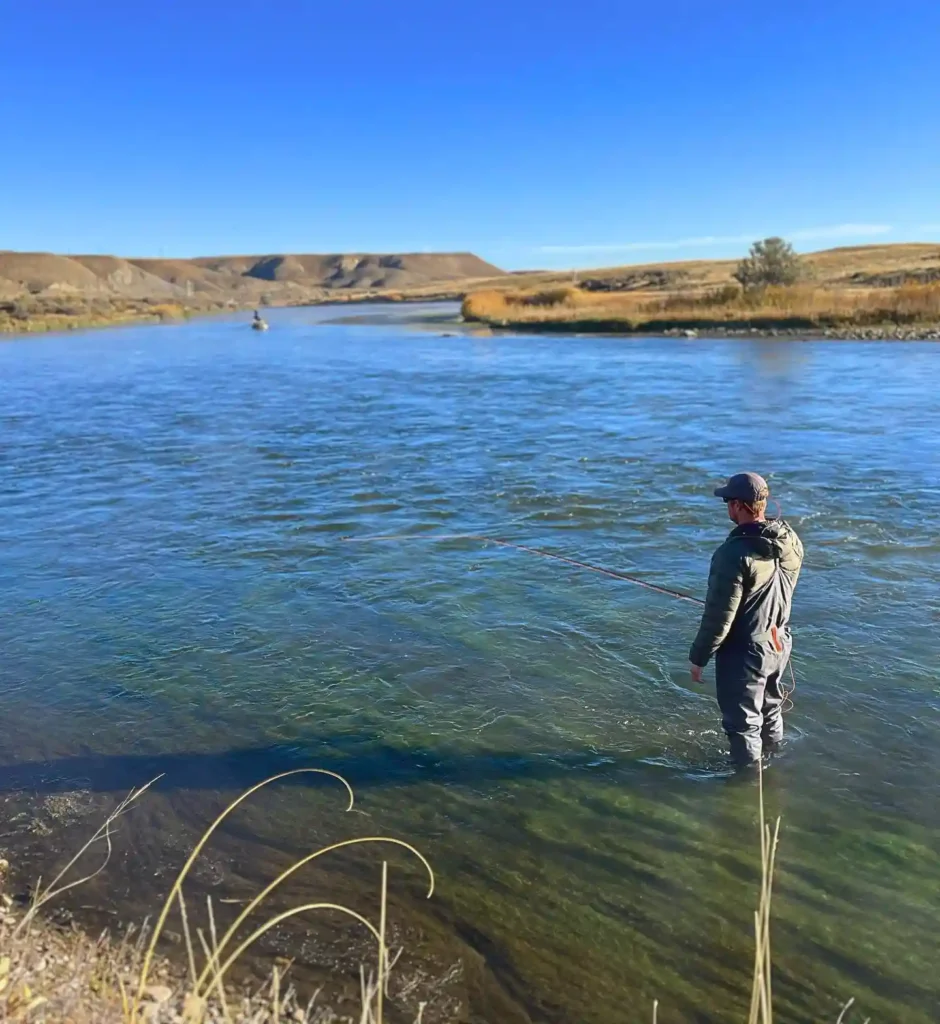
Trout fishing is a popular pastime in the United States, and if you’re looking to get started or improve your skills, you’ve come to the right place. This guide covers the basics and more, from when and where to fish to the gear you need and useful tips.
Whether you’re a complete beginner or an experienced angler, we’ll help you enjoy the serene beauty of the outdoors and the thrill of landing a trout. So, let’s learn about trout fishing and make your next fishing trip a memorable one.
Angler tips and tricks for trout fishing:
Pro Tip 1:
Check Water Temperature: Carry a thermometer when you fish, especially in warmer months. If the water gets above 66°F (18°C), it’s a good idea to put your rod away. You could try fishing for warm water species like bass instead.
Pro Tip 2:
Observe Nature: Take a moment to look around when you’re by the river. Look for insects and check under rocks. The exact pattern of your bait doesn’t matter as much as its size and color, which should match what the trout are naturally eating. If you’re really interested, you can study insects, which can be a fascinating bonus to your fishing journey. And don’t get discouraged, if you lose a fly after finally figuring things out.
Pro Tip 3:
Watch How Fish Behave: Pay attention to how the fish are acting. If they’re poking their backs out of the water, they’re likely feeding just below the surface. If you see their mouths breaking the surface, they’re going for insects on the water’s surface. You might even try changing the way you use your bait based on their behavior.
Pro Tip 4:
Use the Right Gear: Make sure your fishing gear matches the fish you’re targeting and the location you’re in. If you’re after big fish, use a rod that can handle them, so you can reel them in without exhausting them. Also, match your leader size to your fly size. If you’re using heavy flies, go for a thicker leader.
Pro Tip 5:
Be Sneaky: Trout can be easily spooked. Move quietly when you’re getting to your fishing spot, and try not to make big splashes in the water. Keep your casts above the water and away from the fish. If it’s sunny and the water is clear, stand with your back to the sun to avoid being seen by the fish. Remember, just because you can’t see them doesn’t mean they can’t see you.
Pro Tip 6:
Handle Fish Carefully: When you catch a fish, always wet your hands before touching it. Using barbless hooks can make it easier to release the fish quickly. I often pinch my barbs while tying my flies. If possible, use a knotless net. It helps with hook removal and keeps the fish wet, which is important. Also, consider taking photos of the fish while it’s still in the water. With waterproof cameras on phones these days, you can capture great shots of the fish in its natural environment.
Pro Tip 7:
Respect River Etiquette: Understanding the rules of the area you’re fishing in, both written and unwritten, is crucial. Treat fellow anglers with respect. Engaging with them and listening can be a great way to learn. Some of the best fishing tips come from those who’ve been fishing an area for years and are willing to share their knowledge. Remember, the river is for everyone, not just anglers. Give others space, and be considerate of other river users.
Pro Tip 8:
Don’t Hesitate to Explore: If you don’t like the idea of fishing elbow to elbow with other anglers, don’t be afraid to hike a bit to escape the crowds. Make sure your backpack can hold all your gear but remains streamlined so it doesn’t interfere with your fishing.
Pro Tip 9:
Be Aware of Invasive Species: Know the native fish species in your area and report any invasive fish you come across. It’s important to prevent the spread of invasive species through your gear. If you wear felt-wading boots, be sure to clean them thoroughly before your next fishing trip in a different location.
Pro Tip 10:
Always touch them with wet hands: It’s very important to touch them with wet hand because dry hand can harm their outer protective slime layer.
Pro Tip 11:
When you feel that initial strike and the trout is hooked it’s important to set the hook immediately: This quick response ensures that the hook doesn’t penetrate too deeply. Deeply embedded hooks increase the risk of harming or even killing the trout. Being attentive and swift can make a significant difference in the fish’s survival.
Pro Tip 12:
In cases where the hook has penetrated deeply and cannot be easily removed, it’s best to cut the line as close to the hook as possible: Attempting to forcibly extract a deep hook can cause serious harm to the trout’s internal organs or gills. Opting for this method prioritizes the fish’s well-being.
Pro Tip 13:
Removing the hook properly is an important skill for catch and release: To do this, you can use forceps or needle-nosed pliers. It’s essential to handle the trout with care and support its jaw while removing the hook. This minimizes stress and potential injury, increasing the fish’s chances of survival after release.
Pro Tip 14:
Always check the weather forecast before heading out and be prepared with appropriate clothing: Trout are often more active during overcast days or after rain. Use sinking lines or deeper presentations if water temperatures fluctuate.
Pro Tip 15:
Finding the Right Spot: Research your fishing area beforehand. Talk to local anglers, visit fishing forums, or hire a local fishing guide. Understanding trout habitat and behavior will help you find productive spots.
Trout fishing rod and rig setup- a versatile choice:
The term “rig” simply refers to the arrangement of all the tools and gear you’ll need to catch fish. Whether you’re using a fishing rod, carrying equipment by hand, or mounting it on a boat, the rig is your complete setup.
To set up your trout fishing rig, you’ll need the following components:
fishing rod and reel:
Light-weight fishing rod with spinning and casting reel, works well for trout fishing
For Lakes, Ponds, Rivers, and Streams:
For versatility across various trout fishing environments, opt for a fishing rod that’s 6 to 7 feet in length. This length works well for lakes, ponds, rivers, and streams.
Choose a rod with an Ultra-light to light power rating. This means the rod is sensitive enough to detect subtle trout bites but still has enough backbone to handle trout of different sizes.
Look for a rod with a moderate to fast action rating. This describes how the rod bends and recovers. Moderate action rods provide a more flexible, while fast action rods have quicker, stronger recovery.
For wider rivers:
If you plan to do most of your trout fishing in wider rivers, typically spanning 20 to 80 feet across, considering a medium-light rated rod is perfect.
This offers a balance between being lightweight for extended fishing sessions and having the strength to reel in larger trout commonly found in such rivers.
For fly fishing:
For fly fishing as a beginner, a 5-weight fly rod that’s 9 feet long is an excellent choice. This specification includes the weight of the fishing line it’s designed to use. A 5-weight fly rod is versatile and suitable for various trout species and conditions.
Fly rod of medium to fast action allows you to make accurate and efficient casts.
Line:
Most fishing rods and reels come with fishing line, but it’s always a good idea to double-check. If the line isn’t included, you’ll need to purchase separately.
For River and Stream Fishing:
When you’re angling for trout in the flowing waters of rivers and streams, selecting the right fishing line is crucial. Trout can be quite sensitive to line visibility, so you’ll want a low-visibility line.
A 2 to 4-pound test monofilament or fluorocarbon line is an excellent choice for these settings. This thin yet strong line allows for delicate presentations and minimizes the chances of spooking the fish.
For Lakes and Ponds:
Trout fishing in tranquil lakes and ponds demands a line that’s nearly invisible in the clear waters. Opt for a 4 to 6-pound test monofilament or fluorocarbon line to keep your presentation stealthy. Trout are less likely to be deterred by the line’s presence, increasing your chances of a successful catch.
For Fly Fishing:
Fly fishing for trout requires a bit more versatility. You’ll need both floating and sinking lines in your arsenal.
Floating lines are used to present flies on the water’s surface, mimicking natural insect behavior.
For subsurface fishing with streamers and other bait, sinking lines come into play.
Additionally, a 6 to 8-pound test monofilament tippet is a good choice.
Hook:
The best hook size for trout ranges from 4 to 12.
Sinker:
For a successful trout fishing setup, invest in a small bag of split shot weights. These little weights play a vital role in controlling the depth at which your bait or lure swims.
It’s important to pick split shots that are small enough not to pull your bobber underwater, ensuring your presentation remains at the ideal depth to entice trout.
Additionally, if you can find non-lead sinkers, that’s the environmentally friendly choice.
Forceps:
Trout might be small, but they have teeth and narrow mouths that can make unhooking them a tricky task. Having a good pair of hemostats or forceps is a lifesaver for both you and the fish.
These tools ensure you can quickly and delicately unhook caught trout, reducing potential damage.
Trust me!
You don’t want to be the angler trying to handle a trout like a bass.
Landing Net:
When it comes to trout fishing, a landing net is more than a luxury; it’s a necessity.
Trout are well known fighters, and landing them on light lines can be a challenge. Many anglers have learned this the hard way.
Trout also have sensitive skin, and a quality landing net protects their slime coat, allowing them to swim away unharmed.
So, if you’re serious about trout fishing, a landing net is your best friend.
Bobbers:
There’s no need for fancy or complex options, a basic bobber works just fine.
The essential thing to consider is its size. Your bobber should be large enough to prevent your hook and bait from sinking into the water.
This ensures that your presentation stays at the right depth to attract
Baits and Lures:
Selecting the appropriate bait and lures for trout fishing is important and it’s essential to be aware of the regulations in your fishing area and the specific season you’re trout fishing.
Natural and Scented Baits:
These baits include natural fish food like bait fish, crayfish, frogs (when allowed), grubs, insects, larvae, worms, salmon eggs, cheese, and even corn. They should not contain any substances meant to injure, or kill fish.
This category does not encompass artificial flies or lures. It also comprises dough bait and putty or paste-type bait. It involves any substance designed to attract fish through taste or smell and any fly, lure, or bait that contains or is used with such scent-based substances.
Soft Plastic Bait or unscented:
This category includes synthetic eggs, synthetic worms, synthetic grubs, and soft plastic lures. These are usually unscented artificial baits.
Artificial Lure:
An artificial lure is a bait, constructed from various materials, excluding soft plastic bait and the natural and scented bait as defined in categories scented or unscented baits. These lures come in various shapes, sizes, and colors, designed to imitate the appearance of aquatic prey.
Fly:
A fly is an artificial lure constructed on a single-point hook. It can be made from various materials, except for soft plastic bait and the natural and scented bait defined in categories scented and unscented. These flies are typically used in fly fishing and are known for their intricate designs and lifelike imitations of aquatic insects or other prey.
Scent choices for bait:
The four common using scents are:
- Original
- Garlic
- Cheese
- Roe
Pacher rig:
While the poacher rig may not be as widely popular these days, but it’s a secret weapon that can significantly boost your fish-catching success in trout fishing.
This clever setup combines a lure, typically a slow-sinking or shallow-diving plug, with a fly.
What makes the poacher rig stand out is its ability to outperform the standard lure alone. By having both a lure and a fly working in tandem, you increase your odds of enticing trout.
Floating bait rig:
It’s essential to fine-tune your setup. One effective technique is to use a sliding sinker, which allows trout to pick up your bait without sensing the weight.
It’s essential to match the weight to the season and trout behavior.
In the winter when trout tend to stay closer to the shore, opt for lighter weights. These are less likely to spook the fish. In winter, keep the leader at around 2 feet.
However….
As the weather warms and trout move to deeper, cooler waters in the summer, consider using a ½ oz. weight to ensure your bait reaches the desired depth, lengthen the leader to 4 to 5 feet.
As spring arrives and the trout become more active, extend it to 3 feet.
These adjustments make your rig more appealing to trout and increase your chances of a successful catch, no matter the season.
3- way rig:
The 3-way rig is a versatile setup and for me it’s a game-changer in trout fishing. Whether, I’m into drift fishing or casting from shore in a current.
This rig is designed with a specific purpose in mind: keeping the bait off the bottom while securely anchoring it in the midst of tides and currents.
bobber rig:
For novice anglers, the bobber rig is a tried-and-true method for still fishing.
It’s versatile and can be set up in various ways to suit your needs.
The important part is the rig lies in positioning the bobber correctly, taking into account the water’s depth and how high you want to suspend your bait above the bottom.
Setting up the rig:
First tie the hook to the end of your fishing line.
You have two knot options:
- Clinch knot
- Palomar knot.
The Improved Clinch knot is a classic choice, offering a good balance between knot strength and ease of tying.
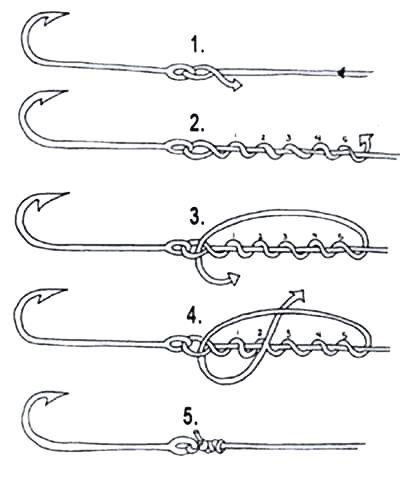
On the other hand, the Palomar knot, while a bit more challenging to tie, provides exceptional knot strength.
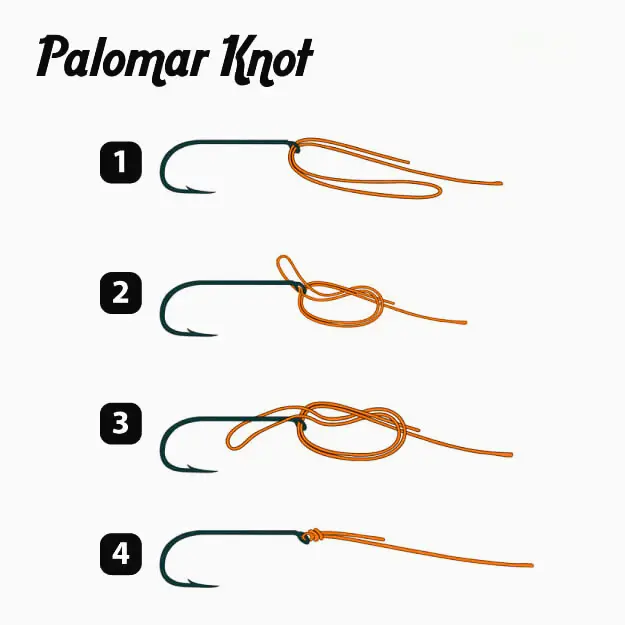
Rest assured, both of these knots are reliable and are unlikely to break, even when targeting sizable trout, as long as you’re using the right line strength.
Once your hook is secure, it’s time to add a split shot weight onto the line, positioning it about 10cm to 15cm above the hook.
If you ever need to remove the split shot, you can do so by squeezing the small tags at the end of it.
The final step is attaching a bobber or float to your fishing line. Thread the line through both the top and bottom metal hooks of the bobber, allowing the line to encircle the bobber’s body and anchoring it in place using both hooks.
Trout fishing lakes and ponds:
In still waters like lakes and ponds, trout are active and on the move in search of food.
However….
They’re also cautious and prefer to stay close to cover for protection.
Where to find them:
So, if you’re looking for trout, check these places in the water:
Near or Above Aquatic Vegetation:
- Keep an eye on areas near or above aquatic plants, like underwater grasses.
- Trout like to hang out here because it offers both food and a bit of cover.
Around Logs, Stumps, and Rocks:
- Trout find comfort and protection near logs, stumps, and rocky structures in the water.
- These spots are excellent for ambushing prey and evading predators.
Stream Inlets:
- Look for trout where streams flow into the lake or pond.
- This is where cool, fresh water enters, often bringing a supply of food. Trout are usually attracted to these areas.
Deeper Waters:
- During the warm summer months, trout often seek deeper waters.
- They look for cooler temperatures and protection from potential threats from above.
Best time to find them:
Trout fishing in lower elevation lakes is most rewarding in the spring and fall when the water is cooler and trout are more active. This is also the time when many lakes are stocked with fish. In the heat of summer, anglers should search for trout in cooler, deeper areas or in high mountain lakes, which remain cool year-round. In warmer regions of the state, like the Willamette Valley or along the coast, trout fishing in lakes and ponds can remain productive even into the winter months, provided you’re prepared for the cold and wet weather.
Technique For trout fishing in lakes and ponds:
When you’re fishing for trout in lakes, you have several options, but here are three straightforward methods that work well:
Suspending Bait under a Bobber:
One of the simplest ways to catch trout in lakes is by suspending bait under a bobber.
To get started, choose a small piece of worm or some Power-Bait, which is the specialized bait for trout. Use a bait hook to secure the bait.
Next, attach a small lead weight to your line just above the baited hook. This weight helps your bait sink to the desired depth.
Now, add a bobber to your line, positioning it about 1 ½ to 3 feet above the hook. The bobber serves as a visual indicator.
Cast your line out to a promising spot and keep an eye on the bobber.
When it starts to wiggle, dive, or jerk, it’s a sign that a trout is interested. This technique is particularly useful when trout are swimming near the surface or when you want to keep your bait suspended above weed beds.
Fishing with Bait off the Bottom:
In some cases, trout may be lurking in deeper waters, and to reach them, you’ll want your bait down where the fish are.
For this method, you won’t use a bobber. Instead, attach a lead weight about 1 ½ feet above the baited hook. This weight causes the bait to sink while keeping it slightly above the lake’s bottom.
Cast your line out to the desired location and let the lead weight do its job. Trout often prefer this presentation when they’re cruising the deeper parts of the lake.
Retrieving a Spinner, Spoon, or Fly:
Another effective way to catch trout in lakes is by using lures such as spinners, spoons, or flies.
These lures mimic the appearance of small minnows or other natural prey that trout love.
To use this method, cast your spinner or spoon over areas where you believe trout might be hiding. Allow the lure to sink for a moment, and then start reeling it in.
Let the spinner sink and the speed of your retrieve until, you find the combination that entices the fish.
It’s correct to say, experimentation is the second name of this technique, and it’s an exciting way to engage trout in lakes.
Trout fishing in rivers and streams:
In rivers and streams, trout have a clever strategy for finding food. They like to stay in one spot and wait for the current to bring them tasty treats, mostly in the form of drifting aquatic insects. They also need a place to relax and hide from danger.
Where to find them:
So, if you’re looking for trout, check these places in the water:
Behind Rocks and Structures:
- Look for water that’s a bit bumpy and rough on the surface, these bumpy patterns happen when the water flows over rocks and boulders on the riverbed.
- Trout often hang out behind these rocks. It’s like a buffet of insects for them, and they get shelter too.
Near Steep or Hidden Banks:
- Keep an eye out for places where the riverbank is very steep or forms a sort of hidden nook.
- Trout love these spots because they provide safety from both the fast water and any fish-hungry creatures.
In Deeper, Slower Pools:
- Search for places in the river where the water is deeper and moves more slowly.
- These calm pools are like rest areas for trout. They can save energy and watch for food drifting by.
Best time to find them:
The best times to catch trout in rivers and streams are typically in the spring and fall. During these seasons, the water temperatures are cooler, making it an ideal time for trout to be active and feeding.
Most of the trout you’ll find in these waters are not stocked; they are naturally reproducing or wild fish. This means they’ve grown up in the wild and have developed their survival instincts, which can make fishing for them more challenging and rewarding.
As the weather warms up, you should shift your focus for trout in faster riffles, these are areas where the water flows more quickly and tumbles over rocks.
Why?
Because, warmer water hold less oxygen, where trout need to breath. But, in riffles, the water gets re-oxygenated as it splashes over the rocks, making it more comfortable for trout.
Now, some rivers, especially those in central Oregon, allow you to fish for trout all year round.
Even in the winter months, when the cold and snow might deter some anglers, you can still enjoy good fishing.
During winter, seek out trout in calm, slow-moving waters where they don’t have to struggle against a strong current.
Pro tip: Trout behavior varies with the seasons, so understanding the water temperature and behavior of the trout can boost your chances of success.
Technique for trout fishing in rivers and streams:
When you’re fishing in a river or stream, it’s the water’s current that influences how your lure moves, not your retrieval.
Here are some effective techniques for catching trout in moving waters:
Casting a spinner or spoon:
If you’re casting spinners or spoons, start by casting your lure slightly upstream and make sure to reel in any leftover slack line.
As the water’s current takes your spinner downstream, try to keep most of your fishing line above the water’s surface to mimic a natural drift. It’s all about making it look like your lure is just drifting along with the current.
When your spinner swings towards the riverbank and lines up with the downstream flow, start a moderate and steady retrieve.
Drifting using worm or, an artificial bait:
For those using drifting bait like worms or artificial options, there’s a different approach. You’ll want to add small weights, known as split shots, to your line to get your bait within a few inches of the riverbed.
This way, your bait will be at the right depth for trout to notice. Additionally, you can attach a bobber to your line. The bobber serves as a handy visual aid, helping you keep track of where your bait is drifting in the water.
Pro tip: Remember that adjusting to the water’s current and using the right techniques can boost your chances of trout fishing in moving water.
Trout fishing in Musky Water:
When you’re fishing in murky water conditions, there are a few adjustments you can make to increase your chances of success. Firstly, it’s a good idea to use a heavier fishing line. The murkiness of the water actually works in your favor here because it helps conceal the thicker line from the fish. A heavier line provides better control and can handle the challenges of murkier waters. Additionally, you’ll want to use a heavier split shot or lure. In these conditions, the water level is often higher and faster moving due to rain or other factors. A heavier split shot helps your bait sink properly and stay in the strike zone despite the swift current.
Trout fishing in Sunny days:
Fishing for trout on bright, sunny days requires some specialized techniques to increase your chances of success.
First, it’s essential to use a light leader line, such as clear nylon sewing machine thread or two-pound test line. In clear water and high visibility conditions, trout can be easily spooked by thicker lines. These finer lines are less likely to deter them. Additionally, polarized sunglasses are indispensable for spotting fish under the water’s surface, as they reduce glare and provide better visibility.
When water levels are low in the spring, it’s a good idea to seek out deeper holes where trout tend to cluster for cooler and more protective environments.
Fly- fishing without using fly rod:
You can absolutely catch trout with artificial flies without using a fly rod. Even anglers with spinning or casting gear can have success in both lakes and streams, often with the assistance of a casting bubble, a transparent bobber positioned above the fly.
If the fish are swimming near the water’s surface, you may not need any extra weight. Simply let the fly glide just inches below the surface.
However,
If you find that the fish are deeper, don’t hesitate to add a small split shot weight or two to your line, positioning them a few feet above the fly. This adjustment can significantly improve your chances of success.
How to Catch Different Types of Trout:
There are various types of trout present, each show specific behavior according to their habitat. They are divided into four categories.
Pacific trout:
Rainbow trout:
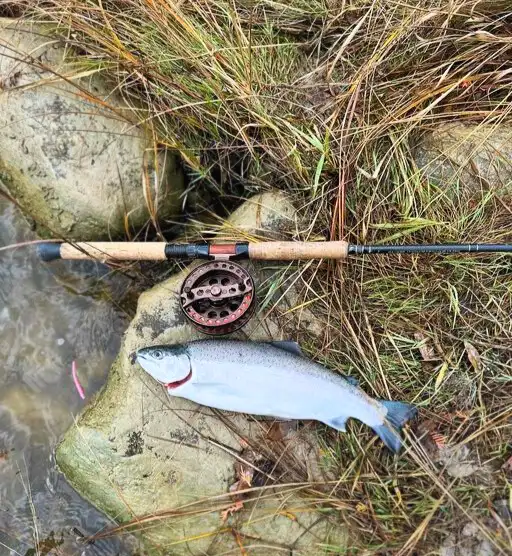
Rainbow trout grows 12 inches in length and are the most popular species across United States. You can find them in Pacific Ocean of US and Asia.
Rainbow trout are an exciting catch for anglers when they jump out of the water after being hooked.
You can recognized them by a pink stripe present at their back, square tail, a dorsal fin and many spots all over the their body.
These unique features are eye-catching for me.
cutthroat trout:
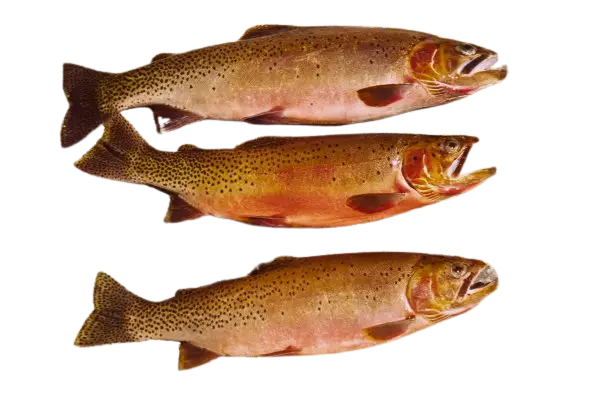
Cutthroat trout have a cooler name compared to their Pacific relatives, even though they are generally smaller.
You can identify them by their red lower jaw or tiny black spots on the upper part of their body.
You’ll spot them in the western United States or southwestern Canada. There are various subspecies, and many national parks have their unique types.
steelhead trout:
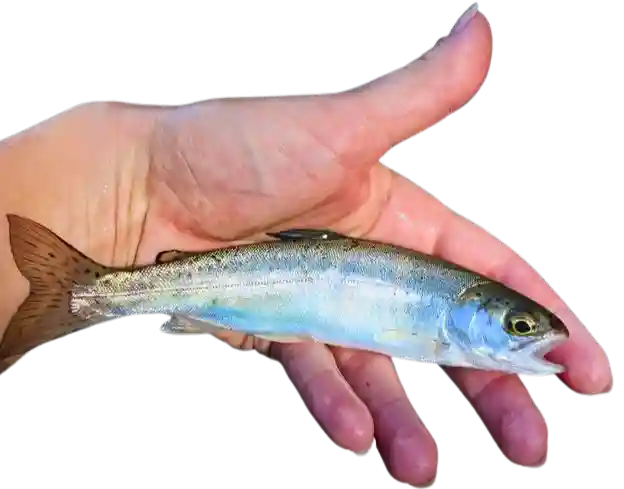
Steelhead trout are fascinating fish that split their time between the Ocean and freshwater. They venture into freshwater mainly for spawning, and this spawning season is when anglers have the best chance of catching them.
What’s impressive about these trout is their potential for growth. They can reach lengths of up to 45 inches and weigh as much as 55 pounds.
It’s the spacious environment of the ocean that allows them to attain such impressive sizes.
European Trout:
brown trout:
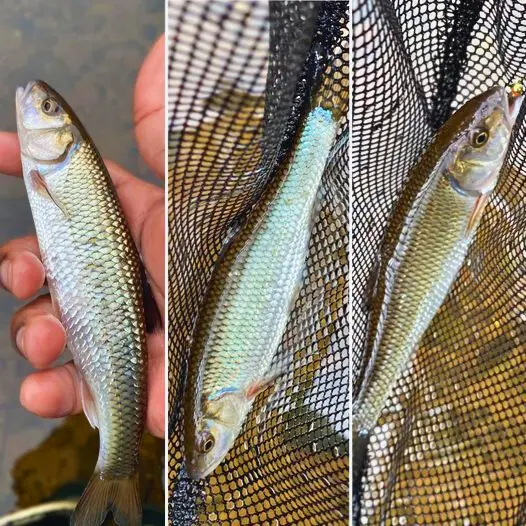
Brown trout, despite their name, often sport a golden or silver hue, complete with an eye catching red-orange spots adorned with silver rings. To find brown trout, search in areas with natural obstacles, particularly those with logs.
They have resemblance with Atlantic trout and were originally native to the United Kingdom.
Brown trout migrate during the season of spawning.
Typically, they measure around 12 inches in length, although the largest can grow up-to 18 inches.
Char trout:
Brook trout:
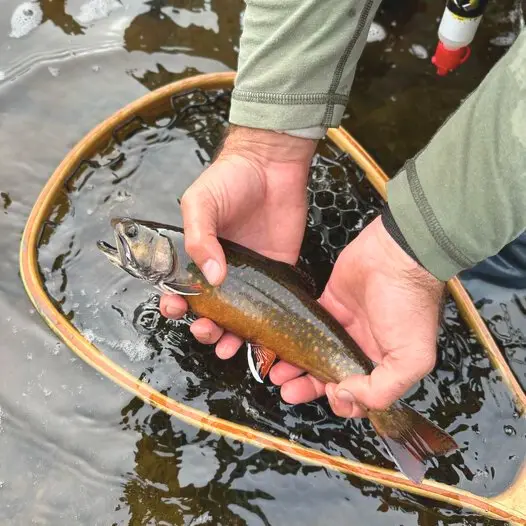
Brook trout are commonly found in North America, recognized by their white-edged fins and distinctive worm-like spots on their head and back.
While they usually don’t grow to hefty sizes, typically staying under 10 pounds, they measure around 8 to 12 inches in length.
These trout have also been introduced in countries like Australia, Europe, Argentina, and New Zealand.
Dolly Varden:
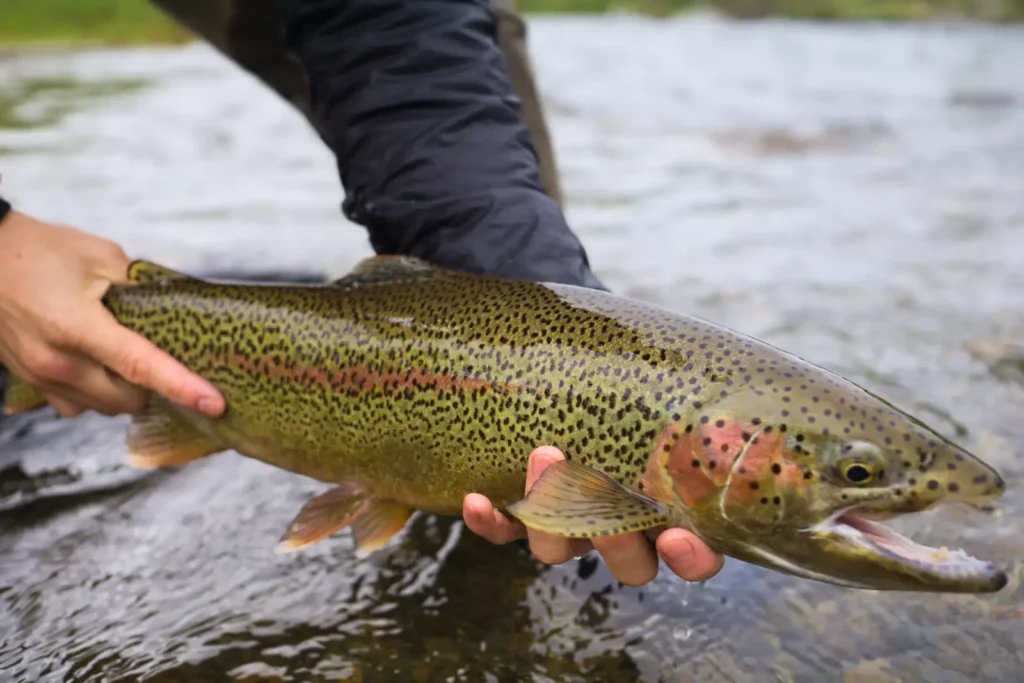
Dolly Varden is anadromous trout species, known for their migration from the Pacific to inland waters for spawning.
Although primarily found in North America and Alaska, they’ve established populations in regions like Japan and Siberia. Dolly Varden are generally small fish, with the largest individuals reaching about 10 pounds.
One distinctive feature is their tail, which differs from the forked shape found in lake trout.
Bull trout:
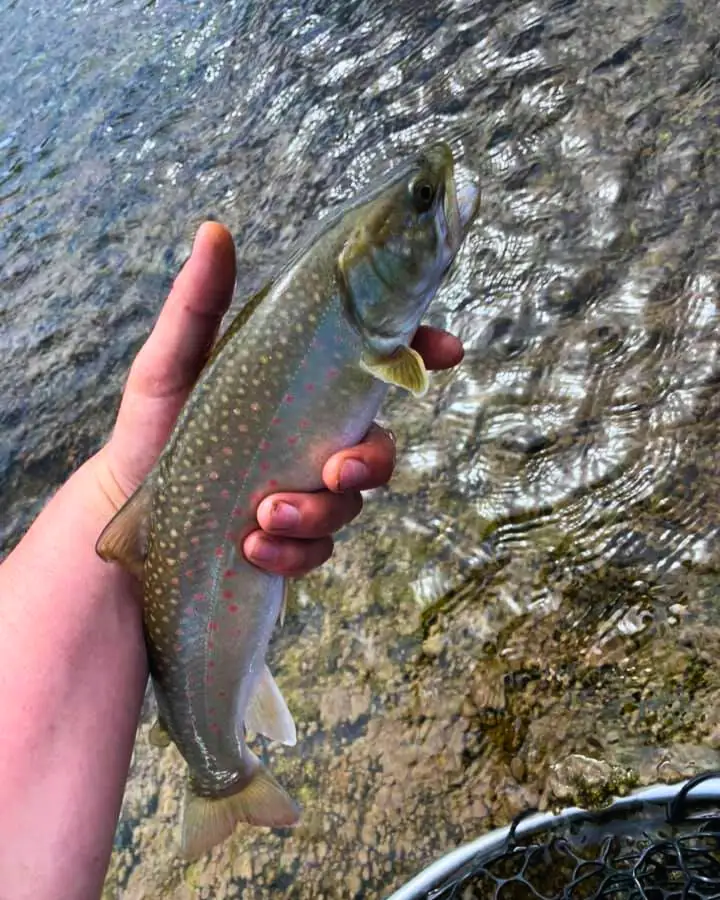
Bull trout are a bit rarer and prefer large, cold rivers and the Pacific Northwest drainages. Ideal fishing spots for bull trout are in Alberta, British Columbia, Oregon, and Washington.
Interestingly, bull trout were often mistaken for Dolly Varden until the 1970s due to their striking resemblance.
They tend to be larger, with some weighing over 12 pounds.
Lake trout:
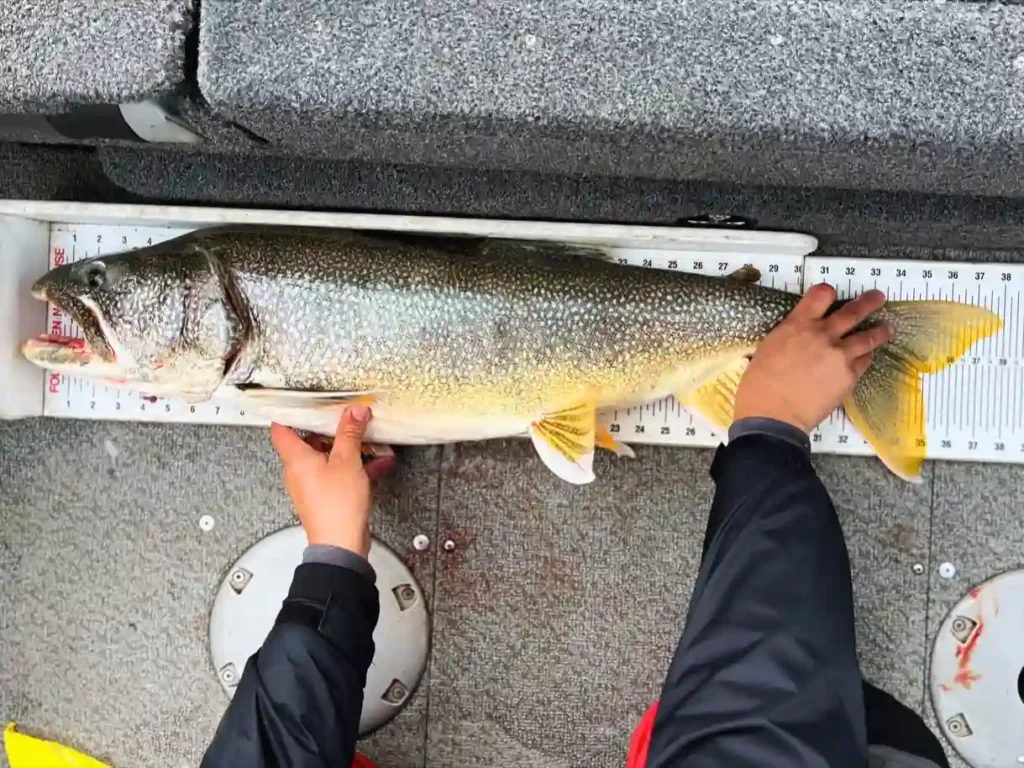
Lake trout are the heavyweight champions among char species. These trout have been known to grow larger than 80 pounds.
Their creamy spots and, of course, their size set them apart. They are native to the northeastern United States, Canada, and Alaska.
You can also find them in places like the Rocky Mountains. Lake trout go by various nicknames, including grey trout, mackinaw, and togue.
Hybrid trout:
Tiger trout:
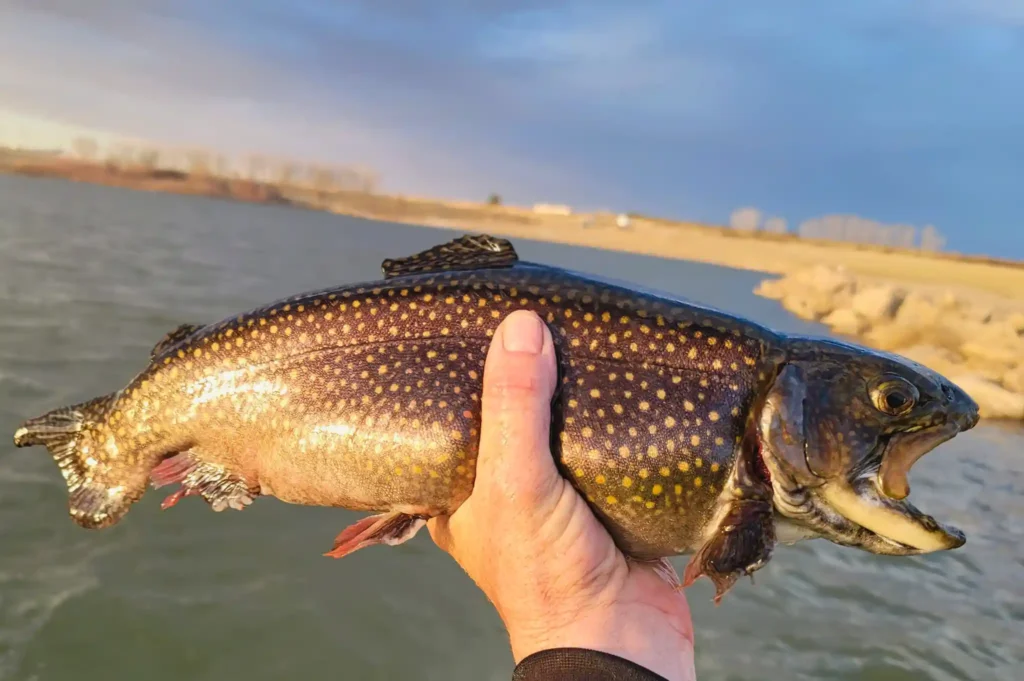
Tiger trout is a hybrid species resulting from a female brown trout and a male brook trout. They’re easy to spot, thanks to the distinctive worm-like patterns adorning their bodies. While they primarily inhabit stocked lakes, lucky anglers might stumble upon them in the wild.
The tiger trout tend to grow larger than many other trout species.
Splake trout:
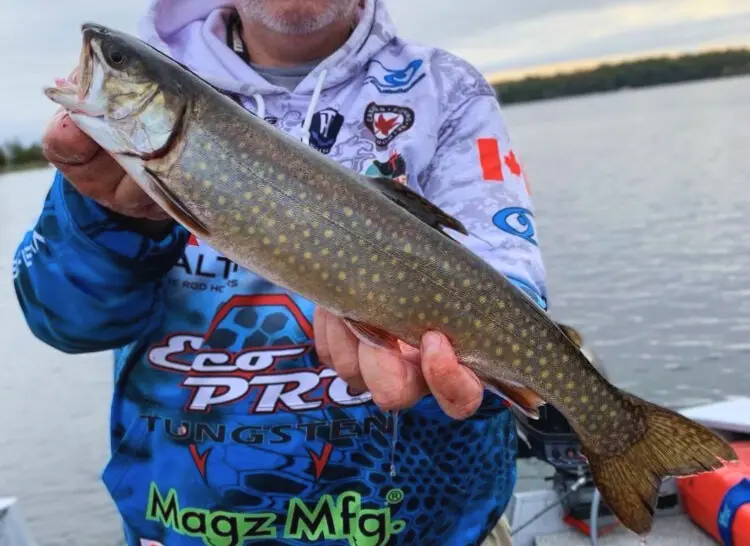
Splake trout, on the other hand, are the offspring of a lake trout.
What sets them apart is their rapid growth rate and early predatory instincts.
They often start hunting at a young age. While Splake trout may reproduce naturally in the wild, most of them come from breeding programs. These programs help maintain populations of this unique hybrid trout.
trout fishing across United States:
Trout fishing is a beloved pastime in the United States, and these fish are typically found in clean, clear, and cool waters, with temperatures ranging between 50–60 °F or, 10–16 °C.
While they tend to thrive in northern and southern latitudes far from the warm tropics, you can also discover them in high-altitude regions, closer to the equator, such as mountainous areas of Ecuador and Peru.
In the US, trout fishing opportunities are abundant. The Rocky Mountains, Pacific Northwest, and states like California and Nevada offer fantastic trout fishing experiences.
Head north-east, and you’ll find equally impressive trout fishing destinations in New York, Vermont, Michigan, and New Hampshire, extending all the way down to North Carolina.
Top Trout Fishing Destinations Across the United States:
Here’s a list of the top trout fishing states and their signature waters:
- Montana: Enjoy the pristine waters of the Bighorn River and the legendary Blackfoot River.
- Idaho: Cast your line into the famous Henry’s Fork River.
- Michigan: Explore the Ausable River and the Manistee River, known for their bountiful trout.
- New York: Head to the Ausable River in this state, where trout are in abundance.
- Colorado: The Frying Pan River is a favorite among trout enthusiasts, offering excellent fishing opportunities.
- Utah: The Green River is the go-to spot for trout fishing, boasting some incredible catches.
- Wyoming: Both the Green River and the state itself are known for excellent trout fishing.
- Pennsylvania: Don’t miss the Yellow Breeches Creek, a renowned trout fishery in this state.
- Arkansas: Enjoy the scenic beauty while fishing along the White River, a popular trout destination.
- North Carolina: The French Broad River is a must-visit location for those seeking trout adventures in this state.
- California: Head to the Truckee River for some rewarding trout fishing in the Golden State.
- Alaska: The Russian River offers a unique experience, combining wild trout and stunning Alaskan landscapes.
- Nevada: The Truckee River also flows through Nevada, promising great trout fishing opportunities.
- New Hampshire: Fish in the Connecticut River, where you can try your luck at catching some remarkable trout.
- Vermont: Enjoy trout fishing along the Connecticut River in this picturesque state.
- Oregon: Venture to the Deschutes River for an unforgettable trout fishing journey in the Pacific Northwest.
Final Thoughts:
Trout fishing is an excellent way to introduce your kids to the world of fishing. It’s a family-friendly activity because it offers a good chance of success, and it won’t break the bank.
When you find the right fishing spot, you can have a blast catching trout all day long, creating wonderful memories with your children.
So, grab your gear, head to your favorite fishing spot, and enjoy quality time with your kids while making some great catches.
Happy fishing!
FAQS:
Q] What type of fishing license is required for trout fishing?
Ans: When you’re planning to go trout fishing, it’s crucial to make sure you have the right fishing license. The type of license you need can vary from state to state, so if you’re fishing in a state other than your own, it’s essential to check their specific regulations. Some states even have agreements that allow them to recognize out-of-state fishing licenses. If you’re just visiting a state for a short fishing trip, some places might offer temporary fishing licenses to accommodate visiting anglers. It’s essential to do your research and ensure you have the correct license to enjoy your trout fishing experience without any legal issues.
Q] Where can I obtain a fishing license for trout fishing?
Ans: For the most current information regarding trout fishing license requirements, it’s advisable to contact your state’s wildlife regulation office or the respective office of any state you plan to visit. You can easily find their websites and contact details online.
Q] When is the optimal time for trout fishing?
Ans: Trout can be caught throughout the year, but experienced anglers often recommend late spring as the prime season. During this time, water levels are higher, and aquatic vegetation is less dense. However, the time of day and the prevailing temperature are crucial factors. A useful guideline for choosing the best fishing time based on temperature is as follows: the higher the expected daily temperature, the earlier in the day you should fish. For instance, if the forecasted high temperature reaches the upper 80s, it’s advisable to be on the water between 6 am and 9 am. Conversely, if the high temperature is expected to be in the low 50s, consider fishing between noon and 5 pm.

4 thoughts on “Trout fishing for beginners: 15 tips & Complete setup guide”